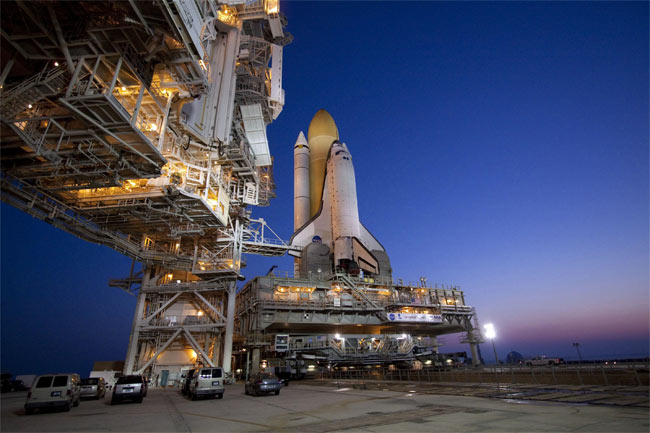Reverence Reigns Over NASA's Final Shuttle Missions

From top mission controllers on through the ranks of astronautsand shuttle workers, reverence reigns over the upcoming last flight of thespace shuttle Atlantis - the first of NASA's final shuttle missions this year.
Atlantis is set to make her 32nd and finalplanned launch from the Kennedy Space Center in Florida on Friday. Themission is the third-to-last shuttle flight ever. The orbiter is slated tocarry six astronauts and a new Russian science module to the InternationalSpace Station.
"There is a little bit of reverence that the missionwill be conducted with given that it?s the final planned flight ofAtlantis," said NASA lead shuttle flight director Mike Sarafin.
There is a small possibility that Atlantis will actuallytake to the skies again after this. The orbiter is tapped as the"launch-on-need" shuttle that would serve as an emergency rescue shipto save astronauts in the event of a major failure during the final shuttlemission on Endeavour, scheduled to launch no earlier than Nov. 26. [MemorableNASA missions.]
Space shuttle retirement ahead
NASA is retiring its decades-old spaceshuttle fleet to focus on building new technology and rockets, such as avehicle to eventually take humans to asteroids or Mars faster than anything yetdeveloped. Meanwhile, President Barack Obama has proposed using privateindustry to pick up the slack in low-Earth orbit, with NASA relying on commercialspacecraft to ferry astronauts and paying passengers to the International SpaceStation.
While Atlantis' upcominglaunch is momentous for some, other NASA officials said they were morefocused on simply getting the job done.
Get the Space.com Newsletter
Breaking space news, the latest updates on rocket launches, skywatching events and more!
"I have not spent a lot of time thinking about lastthis and last that," said John Shannon, NASA's space shuttle programmanager, during a briefing last week. "I think maybe after we get all done,then we'll release the big breath and then maybe think about what it all meantto us. But not while we're in the middle of actually processing and flyingthese vehicles."
Atlantis' STS-132 mission commander, veteran astronautKenneth Ham, echoed that thought.
"This is probably the kind of thing that's really goingto hit all of us after we're done with the mission and we realize what part ofhistory we may have played," Ham said. "I think the space shuttle asa machine is the single most incredible machine humanity has ever built? Theprogram has to come to an end at some point, and it is an honor and privilegefor us to represent being part of that crew at the end."
Atlantis'six-astronaut crew will launch on a planned 12-day mission to deliver thenew Russian "Rassvet" (which means "Dawn" in Russian)science module and vital spare parts for the nearly complete space station.Three spacewalks are planned for the mission.
Legacy in space
Atlantis was the fourth shuttle built, after Columbia,Challenger and Discovery (Endeavour followed later as a replacement forChallenger).
Atlantis was named after a two-masted sailing ship thatserved as a research vessel for the Woods Hole Oceanographic Institute from1930 to 1966. It launched on its first space mission on Oct. 3, 1985.
Some of the past crews that have worked and flown onAtlantis will gather to watch its final liftoff this week, said astronautJerry Ross, a veteran of seven space shuttle missions, five of which have beenon Atlantis.
"I am looking forward to seeing it fly," Rosssaid. "It is a great flying bird. Personally I think it?s the best one ofthe fleet."
- Gallery - Shuttle Atlantis in the Shop for Repairs
- NASA's Most Memorable Space Mission
- What Will NASA Do With the Retired Space Shuttles?
Join our Space Forums to keep talking space on the latest missions, night sky and more! And if you have a news tip, correction or comment, let us know at: community@space.com.

Clara Moskowitz is a science and space writer who joined the Space.com team in 2008 and served as Assistant Managing Editor from 2011 to 2013. Clara has a bachelor's degree in astronomy and physics from Wesleyan University, and a graduate certificate in science writing from the University of California, Santa Cruz. She covers everything from astronomy to human spaceflight and once aced a NASTAR suborbital spaceflight training program for space missions. Clara is currently Associate Editor of Scientific American. To see her latest project is, follow Clara on Twitter.









